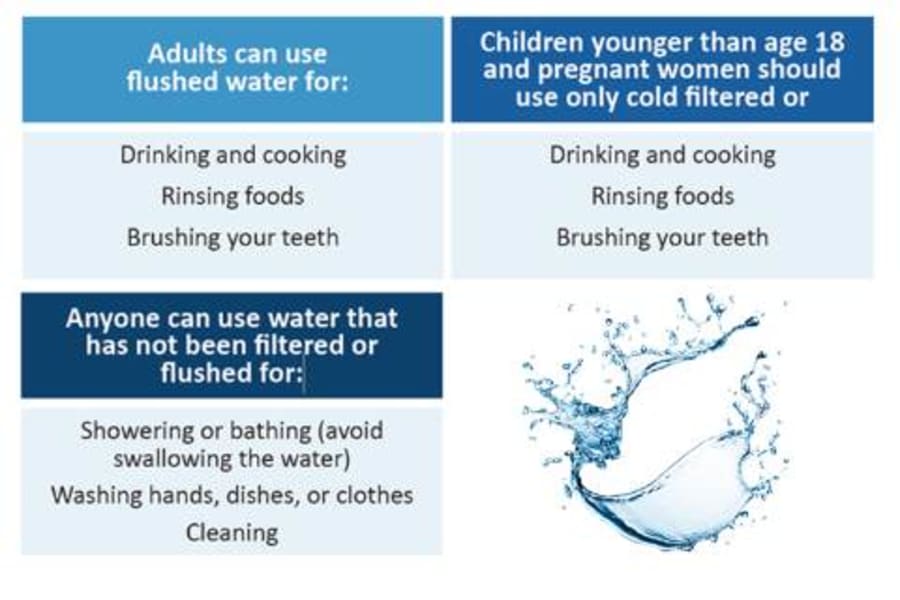REDFORD TOWNSHIP, Mich. – Officials in Redford Township have issued a public advisory after lead was found to be above the Action Level in the water supply. Here’s what you need to know.
The Charter Township of Redford Water Department issued the advisory Wednesday, July 31, after testing revealed lead levels in the community were above the state’s Action Level Exceedance for lead in water.
Recommended Videos
Officials say that lead in the 90th percentile for the city’s water supply is 16 parts per billion (PPB), which exceeds the action level of 15 ppb.
An Action Level Exceedance (ALE) means that more than 10% of the homes tested have results over 15 ppb. The exceedance triggers additional actions, including educational outreach to customers, ongoing sampling every six months, and service line replacement.
When a community has an ALE, the Michigan Department of Health and Human Services (MDHHS) recommends that children under age 18 and pregnant persons should consume only water that is run through a lead-reducing water filter. This recommendation is made because children and fetuses are most at risk of harm to their health from lead.

Redford Township’s water is supplied by the Great Lakes Water Authority, which routinely monitors the source water for lead. If lead was detected in the source water, it would be reported on GLWA’s and Redford Township’s Consumer Confidence Reports.
How does lead get into drinking water?
Lead can enter drinking water when it comes in contact with lead service lines (the pipes that bring water from the water main into your home) or with lead plumbing inside your home. When pipes or faucets containing lead begin to break down, the lead can get into your drinking water. The lead can be dissolved or in small pieces in the water.
How do I test my water for lead?
Testing your water with a certified lab is the only way to find out how much lead is in your drinking water. Your public water supply may offer to test your water for free. If not, you can test it yourself. Visit Michigan.gov/EGLElab and choose “Drinking Water Laboratory” to learn how to order a test kit. The cost is typically $30. If you have questions about testing your water, you can contact MDHHS at 844-934-1315.
What steps can I take to reduce lead in my drinking water?
Use a point-of-use (POU) water filter. A certified lead-reducing filter can reduce lead in drinking water. Filters are made to reduce lead, but do not guarantee that all lead will be removed from drinking water. A POU water filter reduces contaminants at the point water is being used, such as a faucet. Look for these certifications on the filter package: NSF/ANSI Standard 53 for lead reduction and NSF/ANSI Standard 42 for particulate reduction (Class I).
MDHHS recommends that households with, or frequently visited by, children younger than age 18 or pregnant persons use cold filtered water for drinking, preparing food, and cooking. MDHHS recommends using cold filtered or bottled water for mixing powdered infant formula.
A water filter system costs about $30. Replacement cartridges cost about $5-$10 each and should be changed as directed by the manufacturer.
If your household includes or is frequently visited by children younger than age 18 or pregnant persons and unable to afford a water filter system or replacement cartridges, you may be able to get them for free. To find out if you qualify, call your public water supply or Wayne County Public Health Division at 1-866-610-3885.
Get your water moving. Flushing water pipes can reduce the amount of lead in your water. If you have not used your water for several hours, flush your pipes following your public water supply’s recommended amount of time.
Do not use hot water for drinking or cooking. Lead dissolves more easily in hot water. Note: Lead is not removed by boiling water. Do not boil water to reduce lead. Clean your faucet aerators. Clean the mesh screen, or aerator, on the end of your faucet at least every six months. If construction is being done to the water system or pipes near your home-including water meter replacement in your home-check and clean your drinking water faucet aerator every month until the work is done.
Consider replacing older plumbing, pipes, and faucets that may add lead to water. Older faucets, fittings, and valves sold before 2014 may contain up to 8 percent lead, even if marked “lead-free.” Look for replacement faucets made in 2014 or later and make sure they are NSF 61 certified or marked to contain 0.25 percent lead or less. Check your plumbing or hire a plumber to know what parts should be replaced to reduce lead in your drinking water.
Redford Township has set up a webpage to help educate residents regarding the ALE. It features information on how to test tap water, obtain water filters, reduce exposure and more. It can be found here.
More information on lead can be found on the Wayne County Health, Human and Veterans Services page here.

